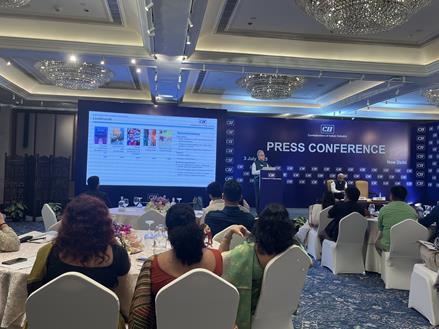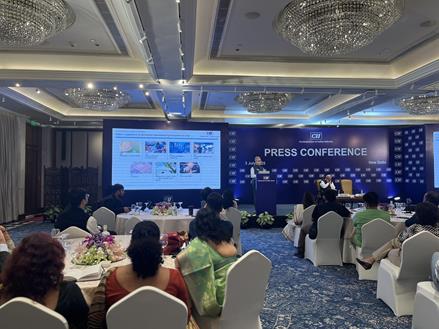India’s Economic Outlook: CII Charts Path to Competitiveness and Growth
Rajiv Memani, President of the CII India, unveiled CII’s agenda for next-generation reforms under the theme “Accelerating Competitiveness.”
New Delhi – In a press conference held at the Hotel Taj Mansingh, Mr. Rajiv Memani, Chairman and CEO of EY India and the newly appointed President of the Confederation of Indian Industry (CII) for 2025-26, outlined an ambitious vision for India’s economic future. Against a backdrop of global economic volatility, Memani emphasised India’s resilience as the world’s fastest-growing major economy and unveiled CII’s agenda for next-generation reforms under the theme “Accelerating Competitiveness.” The agenda aims to propel India toward its goal of becoming a developed nation—Viksit Bharat—by 2047.
Chairman and CEO of EY India and the newly appointed President of the Confederation of Indian Industry (CII) for 2025-26, outlined an ambitious vision for India’s economic future. Against a backdrop of global economic volatility, Memani emphasised India’s resilience as the world’s fastest-growing major economy and unveiled CII’s agenda for next-generation reforms under the theme “Accelerating Competitiveness.” The agenda aims to propel India toward its goal of becoming a developed nation—Viksit Bharat—by 2047.
Economic Growth Projections
CII’s GDP Growth Model, incorporating 34 high-frequency indicators spanning investment, consumption, prices, labour, trade, and global volatility, projects India’s real GDP growth for FY26 at 6.4–6.7%. This forecast reaffirms India’s position as a global economic leader despite challenges such as geopolitical tensions and trade disruptions. “India stands out as a bright spot in an increasingly fractured global economy,” Memani stated, attributing this resilience to robust domestic demand and sound macroeconomic fundamentals.
However, Memani cautioned that sustaining this growth requires mission-driven reforms. “Competitiveness is India’s passport to prosperity,” he said, stressing the need for reforms in ease of doing business, manufacturing, technology, sustainability, livelihoods, and trust. These form the six sub-themes of CII’s 2025-26 agenda, designed to enhance India’s global standing through scale, productivity, innovation, and resilience.
CII’s Theme: Accelerating Competitiveness
CII’s theme for 2025-26, “Accelerating Competitiveness,” reflects the urgency of aligning India’s economic strategies with the rapidly evolving global landscape. Memani highlighted that competitiveness today extends beyond cost, encompassing speed, scale, quality, trust, and sustainability across various sectors, including manufacturing, agriculture, services, infrastructure, and technology. The sub-themes—Next-Gen Reforms, Manufacturing, Technology and AI, Sustainability and Energy Transition, Livelihoods, and Trust—provide a comprehensive framework for action.
Next-Generation Reforms
CII’s reform agenda focuses on streamlining business operations and fiscal policies. To enhance ease of doing business, CII proposes legislative backing for the National Single Window System (NSWS) with time-bound, faceless approvals and explicit service-level guarantees. A Central Tribunal Authority, along with Arbitration and Mediation Councils, is recommended to reduce the backlog of economic litigation, which currently locks up over ₹31 lakh crore in tax disputes.
On fiscal reforms, CII advocates for independent State Fiscal Councils to assess state budgets and debt sustainability. To meet infrastructure and developmental needs, Memani suggested augmenting government revenues through calibrated disinvestment of public sector enterprises. Proceeds could be used to fund public capital expenditure, retire debt, or establish a Sovereign Wealth Fund for strategic overseas investments.
Tax reforms are another priority. CII proposes a simplified three-tier GST structure: 5% for essential goods, 28% for demerit goods, and a converged rate of 12–18% for all other goods, with petroleum, electricity, real estate, and alcohol included under GST. Import tariffs should follow a three-tier model (0–2.5% for raw materials, 2.5–5% for intermediates, 5–7.5% for final goods) to encourage global value chain (GVC) integration. To address tax litigation, CII recommends prioritising high-value cases, strengthening Alternative Dispute Resolution, and introducing an “Accelerated APA” window for faster resolutions.
Environmental regulations also need simplification. CII calls for a unified compliance framework that integrates state and central clearances, with automated renewals and third-party audits for low-risk industries, to reduce delays.
Manufacturing: The Engine of Growth
Manufacturing is central to achieving Viksit Bharat, yet India’s share in global manufacturing value added remains at 2.8%, compared to China’s 28.9% and the US’s 17.1%. To address this, CII proposes structuring the National Manufacturing Mission as an empowered platform with a three-tier governance model to drive execution across ministries and states. A Sub-Mission on Advanced Manufacturing would focus on cutting-edge technologies.
To support medium-scale manufacturing, CII recommends a Capital Support Scheme that covers 50% of the equity capital for projects between ₹50 crore and ₹1,000 crore, with repayment due over a period of ten years. A Fund-of-Funds would invest in manufacturing SMEs and support technology acquisitions. Labour market reforms include a Voluntary Code on Labour Welfare, expanding social security to gig and informal workers, enabling night shifts for women with safety measures in place, and upgrading the Shram Suvidha portal into a unified compliance platform.
 To secure critical minerals and rare earths, CII recommends automatic mining rights for exploration license holders, a National Critical Minerals Data Repository, and dedicated FTA chapters with mineral-rich countries like Australia and Chile. Logistics costs, a significant burden, can be reduced through dedicated railway freight corridors, rationalised tariffs, improved port connectivity, and a single digital document for clearances. Power sector reforms, including reduced cross-subsidisation and privatised distribution, are also critical.
To secure critical minerals and rare earths, CII recommends automatic mining rights for exploration license holders, a National Critical Minerals Data Repository, and dedicated FTA chapters with mineral-rich countries like Australia and Chile. Logistics costs, a significant burden, can be reduced through dedicated railway freight corridors, rationalised tariffs, improved port connectivity, and a single digital document for clearances. Power sector reforms, including reduced cross-subsidisation and privatised distribution, are also critical.
Technology and AI Leadership
To position India at the forefront of global technological transformation, the CII advocates for a National AI Authority, a National AI Public Stack, and investments in semiconductor fabs, cloud infrastructure, and the development of AI skills. Regulatory sandboxes and open data ecosystems would accelerate AI adoption in MSMEs, healthcare, manufacturing, and services, while addressing potential employment impacts in a responsible manner.
Sustainability and Energy Transition
India’s ambitious energy transition goals necessitate sector-specific strategies, particularly in the mobility, green hydrogen, and renewable energy sectors. CII suggests amending nuclear energy laws to facilitate early implementation and supporting MSMEs in meeting global sustainability standards through initiatives like SustainBridge.
Livelihoods: Agriculture and Employment
In agriculture, CII recommends shifting from output-based subsidies to an “income-per-acre” framework to enhance productivity, profitability, and preservation. Policy support should focus on climate-resilient value chains, promoting Farmer Producer Organisations (FPOs) with tax waivers, and establishing a National Cold Chain Corporation through public-private partnerships. A Production-Linked Incentive (PLI) scheme is also proposed for cold chain players.
For employment, CII emphasises leveraging India’s demographic dividend, which is expected to peak around 2043. A comprehensive Labour Market Information System (LMIS) integrating central and state portals, a National Policy on the Gig Economy, and a National Demand Aggregation Mechanism for skilling are recommended. The concept of “Skilling-as-Infrastructure” would integrate skilling into investment pipelines, ensuring a market-ready workforce.
Building Trust and Global Integration
Trust is a cornerstone of CII’s agenda, encompassing transparent governance, fair business practices, and societal engagement. To enhance GVC participation, CII proposes a nodal body for inter-ministerial coordination and GVC mapping in FTAs. Deepening Asia-Pacific integration through renegotiated trade agreements and addressing carbon costs in the India-EU FTA talks are also crucial to mitigating the impact of the Carbon Border Adjustment Mechanism (CBAM).
CII’s Action-Oriented Initiatives
Concrete initiatives back CII’s agenda. The organisation will expand its Model Career Centres from 48 to 100 and Multi-Skill Training Institutes from 7 to 36 in the 2025-26 financial year. The Entrepreneurs Development Forum will support 10,000 microentrepreneurs across 50 districts, while the Financial Access Program will improve MSMEs’ access to credit. The OEM–MSME Supplier Rating Program will promote quality and green practices, and the Climate Adaptation Mission for Industry will enhance sectoral resilience. CII’s mission on Critical Minerals and energy transition will ensure a secure and sustainable industrial future.
India’s Path to Viksit Bharat
Memani concluded by reiterating CII’s commitment to working with the government, industry, and citizens to accelerate India’s rise as a competitive, resilient, and inclusive economy. “India’s growth must be anchored in competitiveness, rooted in scale, productivity, innovation, and resilience,” he said. With its comprehensive reform agenda and actionable initiatives, CII aims to transform India into a global economic powerhouse, ensuring prosperity for all by 2047.
